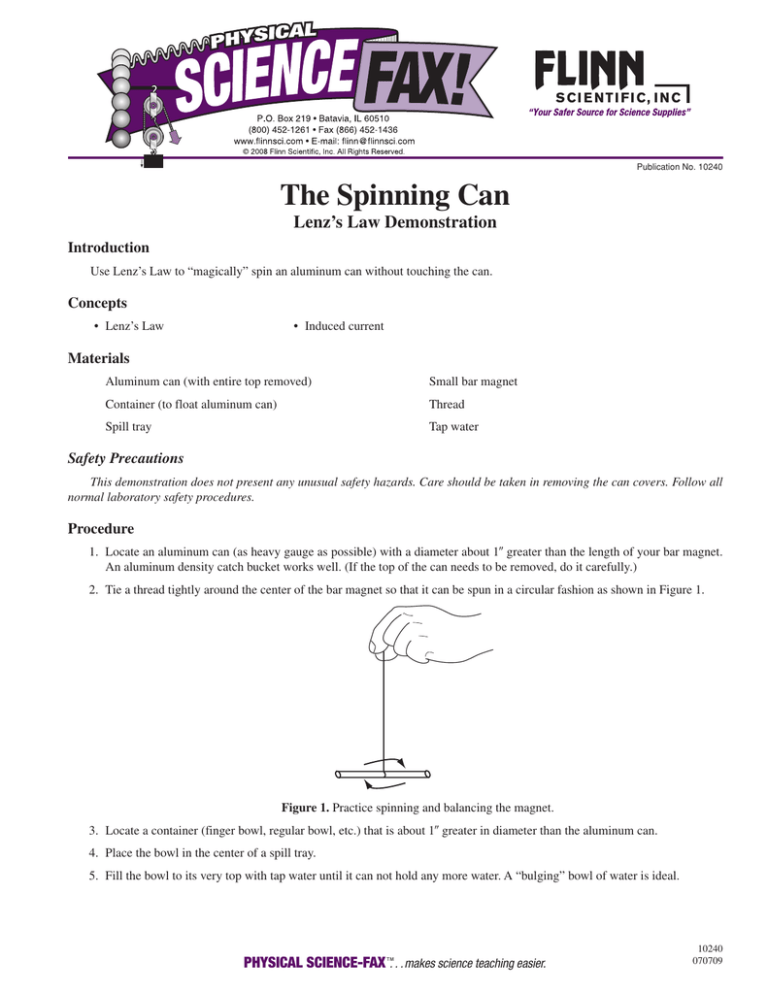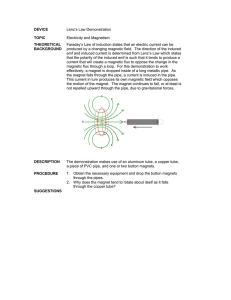
Publication No. 10240
The Spinning Can
Lenz’s Law Demonstration
Introduction
Use Lenz’s Law to “magically” spin an aluminum can without touching the can.
Concepts
• Lenz’s Law
• Induced current
Materials
Aluminum can (with entire top removed)
Small bar magnet
Container (to float aluminum can)
Thread
Spill tray
Tap water
Safety Precautions
This demonstration does not present any unusual safety hazards. Care should be taken in removing the can covers. Follow all
normal laboratory safety procedures.
Procedure
1. Locate an aluminum can (as heavy gauge as possible) with a diameter about 1⬙ greater than the length of your bar magnet.
An aluminum density catch bucket works well. (If the top of the can needs to be removed, do it carefully.)
2. Tie a thread tightly around the center of the bar magnet so that it can be spun in a circular fashion as shown in Figure 1.
Figure 1. Practice spinning and balancing the magnet.
3. Locate a container (finger bowl, regular bowl, etc.) that is about 1⬙ greater in diameter than the aluminum can.
4. Place the bowl in the center of a spill tray.
5. Fill the bowl to its very top with tap water until it can not hold any more water. A “bulging” bowl of water is ideal.
PHYSICAL SCIENCE-FAX姠. . .makes science teaching easier.
10240
070709
6. Carefully float the aluminum can open-side-up on top of
the water. The final setup should look like Figure 2.
7. With the magnet hanging outside the can, start the magnet
spinning on the hanging thread. Spin and balance the magnet so it is spinning in a level, even fashion. Then slowly
lower the spinning magnet down inside the lip of the can,
being careful to not touch the side of the can. (This might
take a little practice and a steady hand.)
8. Watch what happens to the floating can. What direction
does it spin compared to the magnet? What happens when
the thread is completely unwound and the magnet spins in
the opposite direction?
Thread
Bar Magnet
Heavy Gauge
Aluminum Can
H2O
Bowl
Spill Tray
Figure 2.
Disposal
Please consult your current Flinn Scientific Catalog/Reference Manual for general guidelines and specific procedures, and
review all federal, state and local regulations that may apply, before proceeding. The water may be poured down the drain according to Flinn Suggested Disposal Method #26b.
Connecting to the National Standards
This laboratory activity relates to the following National Science Education Standards (1996):
Unifying Concepts and Processes: Grades K–12
Evidence, models, and explanation
Content Standards: Grades 5–8
Content Standard B: Physical Science, properties and changes of properties in matter, motions and forces, transfer of
energy
Content Standards: Grades 9–12
Content Standard B: Physical Science, structure and properties of matter, motions and forces, interactions of energy and
matter
Tips
• Practice spinning and balancing the magnet prior to the demonstration as shown in Figure 1.
• The aluminum can should be as thick walled as possible. A soda can does not work well and has sharp edges when the
entire top is removed. An aluminum catch bucket works well.
• This demonstration can be very dramatic if performed on an air table instead of on floating water.
• The right combination of sizes of parts is what makes this demonstration successful. The can needs to float on a high
meniscus of water and therefore the bowl should be only slightly bigger in diameter than the can. If floating properly, the
can should not touch the sides of the bowl. (A tea cup of the right size works well.)
Discussion
In 1834 Henrich Lenz put forward his Law of Induction: An induced current in a closed conducting loop will appear in such
a direction that it opposes the motion that produced it.
This “induced opposition” (often called Eddy currents) has been demonstrated in many ways since Lenz first formulated the
principle. A classic demonstration has been to drop a strong magnet through a conducting tube to show how the created Eddy currents “oppose” the pull of gravity. The induced opposition causes the magnet to fall very slowly through the tube. It is a great demonstration to show the relationship between Lenz’s Law and the Law of Conservation of Energy.
–2–
© 2009 Flinn Scientific, Inc. All Rights Reserved.
The spinning aluminum can in this demonstration illustrates the same principles. The can will spin in the induced currents
created between the spinning magnet and the aluminum can. It is actually being repelled by response to the induced current from
the spinning magnet. The “phase shift” is very dramatic when the induced field direction is reversed and the magnet starts spinning in the opposite direction. The can “magically” reverses its spinning direction too.
Reference
Dindorf, W. Lenz’s Law in the Kitchen. The Physics Teacher. Vol. 37, May, 1999.
Materials for The Spinning Can—Lenz’s Law Demonstration are available from Flinn Scientific, Inc.
Catalog No.
AP4698
AP9261
AP4626
Description
Eddy Current Experiment Kit
Bar Magnet, Cobalt Steel
Catch Bucket, Aluminum
Consult your Flinn Scientific Catalog/Reference Manual for current prices.
–3–
© 2009 Flinn Scientific, Inc. All Rights Reserved.
10240


